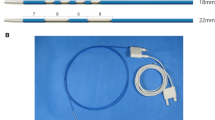Abstract
Background
We have reported that percutaneous radiofrequency ablation (RFA) with balloon occlusion of the hepatic artery (balloon-occluded RFA), using an expandable electrode, increases the coagulation area. In this study, we investigated the efficacy of balloon-occluded RFA and balloon-microcatheter-occluded RFA, using a cool RF single electrode.
Methods
We studies 41 patients with 47 hepatocellular carcinoma (HCC) lesions. We treated 28 patients (32 nodules) with balloon-occluded RFA, 5 patients (6 nodules) with balloon-microcatheter-occluded RFA, and 8 patients (9 nodules) with standard RFA. Initial therapeutic efficacy was evaluated with dynamic computed tomography performed 1 week after one session of treatment.
Results
One session of treatment was done for 20 nodules (62.5%) in the balloon-occluded RFA group and for 4 nodules (66.7%) in the balloon-microcatheter-occluded RFA group. We compared the coagulation diameter for balloon-occluded RFA (7 nodules), balloon-microcatheter-occluded RFA (6 nodules), and standard RFA (9 nodules) after one application cycle (12 min). The greatest dimension of the area coagulated by balloon-occluded RFA was significantly larger (greatest long-axis dimension, 47.6 ± 7.8 mm; greatest short-axis dimension, 33.4 ± 7.5 mm) than that coagulated by standard RFA (greatest long-axis dimension, 35.3 ± 4.7 mm; greatest short-axis dimension, 25.9 ± 3.7 mm; P = 0.002 for greatest long-axis dimension; P = 0.041 for greatest short-axis dimension). However, there was significant difference only in the greatest short-axis dimension of the area coagulated comparing balloon-microcatheter-occluded RFA and standard RFA.
Conclusions
We consider balloon-occluded RFA using a cool RF electrode to be superior to standard RFA for the treatment of HCC, especially when larger coagulation volumes are required.
Similar content being viewed by others
Author information
Authors and Affiliations
Rights and permissions
About this article
Cite this article
Yamasaki, T., Kimura, T., Kurokawa, F. et al. Percutaneous radiofrequency ablation with cooled electrodes combined with hepatic arterial balloon occlusion in hepatocellular carcinoma. J Gastroenterol 40, 171–178 (2005). https://doi.org/10.1007/s00535-004-1516-5
Received:
Accepted:
Issue Date:
DOI: https://doi.org/10.1007/s00535-004-1516-5




